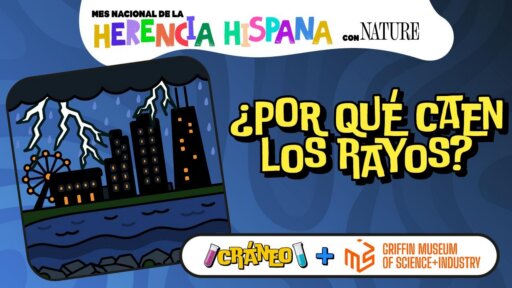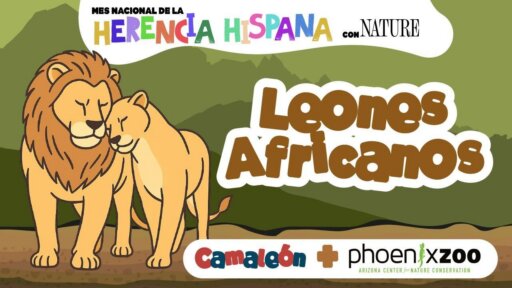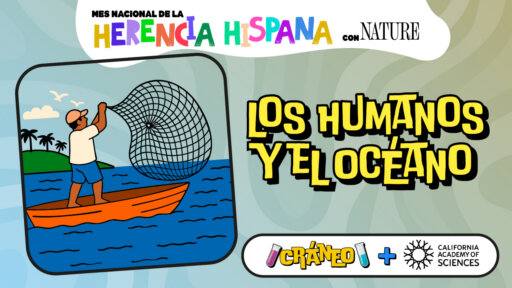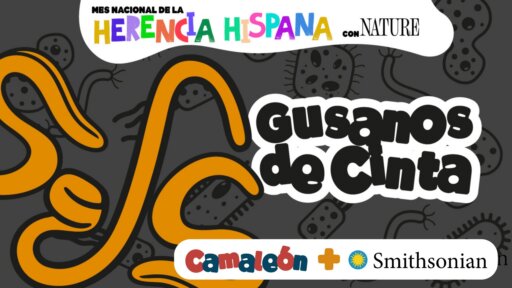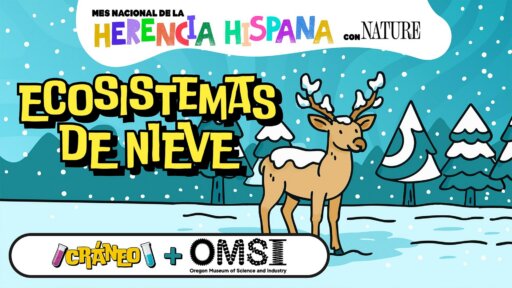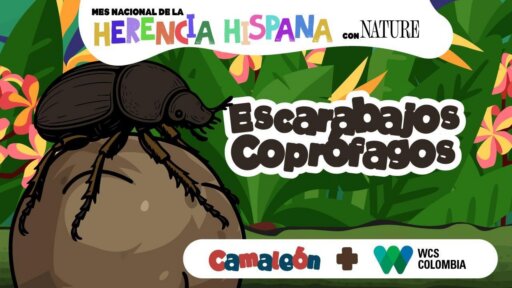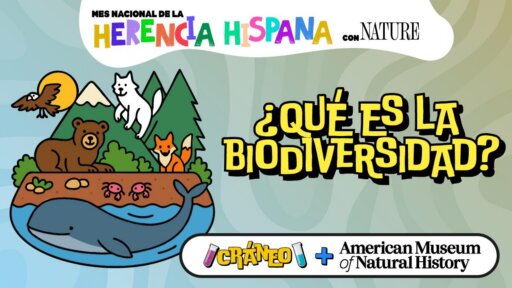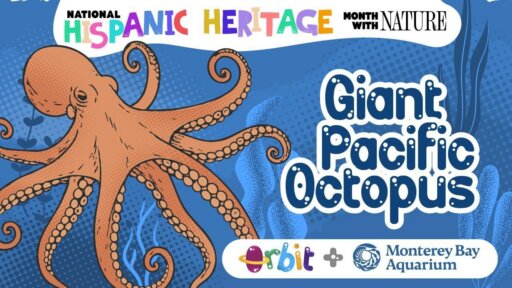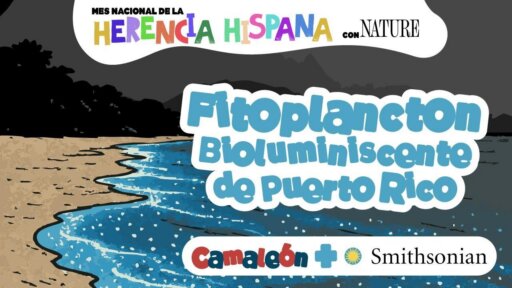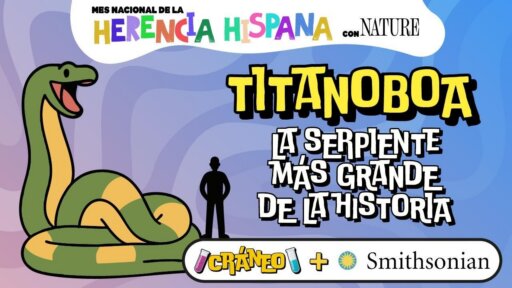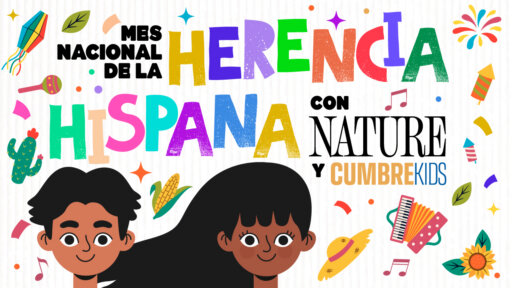TRANSCRIPT (ES)
Gerwuin José Riera Salcedo 00:00
Hola padres este episodio forma parte de una celebración especial del Mes de la Herencia Hispana. Queremos dar un agradecimiento especial durante este mes al equipo de PBS Nature quienes han sido colaboradores en hacer posible este contenido. Ok y también padres hemos producido este episodio en inglés. Son nuestros primeros episodios del nuevo podcast Orbit Science for kids on the move. Los invitamos a todos a seguir este podcast en su plataforma de podcast para seguir el aprendizaje y diversión en inglés. Y si tus peques quieren enviar preguntas, lo pueden hacer directamente a triple www.cumbrekids/preguntas o yendo al enlace que estamos dejando en la descripción. Bien, ahora sí vamos a comenzar.
Gerwuin 00:49
OK, camaleones, imaginen que están buceando en el océano y de repente, frente a ustedes aparece una criatura enorme con ocho brazos llenos de ventosas, tres corazones latiendo y nada menos que nueve cerebros trabajando al mismo tiempo. Parece un monstruo de otro planeta, pero no es un animal real. El pulpo gigante del Pacífico.
Niños 01:24
Hola, ¿por qué el pulpo gigante tiene muchos cerebros? ¿En qué se encarga cada uno de estos cerebros? ¿Cómo es que los pulpos lanzan tinta? ¿Qué tan inteligentes pueden llegar a ser estos pulpos?
Gerwuin 01:43
Hoy tenemos con nosotros a alguien que lo conoce muy bien porque lo cuida todos los días. En el acuario nos acompaña René Carvajal, biólogo marino del Monterey Bay Aquarium en California.
Rene Carbajal 01:54
Hola amiguitos y amiguitas, estoy encantado de saludarlos desde nuestro acuario. Estamos acá en la costa central de California, desde los Estados Unidos.
Gerwuin 02:03
Junto a él, vamos a descubrir por qué este pulpo es uno de los genios del océano.
Isa y Ger 02:18
OK, camaleones, sean todos bienvenidos a un nuevo episodio yo estoy con misa vela hoy Hola Isa Cómo estás
Isabella 02:25
Muy bien Gerwiny tú y hola también a nuestros mini radioescuchas que hacen posible este podcast.
Gerwuin 02:32
Asi es, sean todos bienvenidos. Isa como estas? Como te va el dia de hoy
Isabella 02:33
Very good, Very good, y excelente
Gerwuin 02:37
Very good Very good y excelente. Cuéntame. Entonces, ¿qué ha pasado los últimos días contigo?
Isabella 02:48
Ger, Imagínate.
Gerwuin 02:49
Sí
Gerwuin 02:52
Está mejorando.
Isabella 02:53
Sí
Isabella 02:55
Que hoy tenemos el día de la movilidad segura en mi colegio.
Gerwuin 02:59
¿Qué significa movilidad segura?
Isabella 03:02
O sea que todos nuestros amiguitos llevaron monopatín, bicicleta.
Gerwuin 03:09
Ay qué chévere? Y la tarea es o sea, la actividad es moverse…
Isabella 03:14
Es moverse alrededor del colegio en una cancha que pusieron entonces tenían buscar de la cancha respetando los cruces peatonales
Gerwuin 03:24
Ah las señales de tránsito.
Isabella 03:28
sí, los semáforos y todo eso
Gerwuin 03:31
Súper. Entonces, me encanta esta idea. ¿Sabes por qué? Porque las familias de los camaleones que nos están escuchando pueden hacer actividades como estas. Que ¿Qué idea les das?
Isabella 03:41
Les doy la idea de que hagan cosas así y que podamos hacer cosas divertidas, como llevar nuestros scooters, nuestras maletas, todas las cosas. Y entonces para que así todos los niños aprendamos a cómo manejar vehículos de forma segura.
Gerwuin 04:02
Muy bien, Isa, hoy tengo para ti algo preparado. Es una carrera muy chévere para comenzar este episodio, hoy narraremos una carrera en las profundidades del océano. Cuatro competidores marinos ya están listos en la línea de salida, listos para ser presentados. ¿Estás lista para presentarlos?
Isabella 04:26
Lista. El primero es tinta rápida, un joven pulpo que nada soltando chorros de agua y tinta para deslizar a sus rivales.
Gerwuin 04:36
En la segunda, la pista es, doña Medusa flash parece lenta, pero con cada movimiento de sus campanas, se impulsa como un cohete gelatinoso.
Isabella 04:46
Número tres caballito turbo es un caballito de mar pequeñito, pero se mueve con su cola como hélice para ser sorprendentemente rápido. O sea que no te dejes engañar por las apariencias
Gerwuin 05:01
Exactamente. Y cerramos con don Cangrejo acorazado, no nada muy veloz, pero se arrastra por el fondo marino con sus pinzas listas para apartar a cualquiera del camino.
Isabella 05:12
Qué carrera tan extraña camaleones. ¿Quién cree que ganará? Piénselo porque la carrera empieza ya
Gerwuin 05:21
y allá van tinta rápida arranca con un chorro de agua y tinta oscura que le lanza hacia adelante.
Isabella 05:27
Pero Medusa flash se impulsa con sus campanas y alcanza el primer lugar.
Gerwuin 05:33
Caballito turbo da un giro de cola y acelera como loco.
Isabella 05:37
Uy pero tropieza con una corriente y don Cangrejo acorazado sigue firme por el fondo, adelantando poco a poco
Gerwuin 05:45
Ultimos metros, últimos metros tinta rápida y Medusa flash están muy parejos,
Isabella 05:51
Pero con el último impulso gana caballito turbo el más pequeñito de todos
Gerwuin 05:57
Bravo caballito turbo muy bien lo que tú habías dicho. Isa.
Gerwuin 06:06
Muy bien, Isa me encanta jugar contigo. Así que ya pues vamos a entrar en el tema de este episodio. Hoy vamos a hablar del pulpo gigante del Pacífico. ¿Habías escuchado ese animal
Gerwuin 06:18
No, que estamos viendo en pantalla, Isa?
Isabella 06:18
Never
Isabella 06:18
Es un pulpito. Es como anaranjado, hay uno que tiene unos puntitos blanquitos.
Gerwuin 06:19
Si, hay uno que tiene unos puntitos blanquitos. Lo estamos viendo acá, pero ustedes lo pueden ver en Spotify en lo que está haciendo allí. Jorge Wake ¿Qué más vemos? ¿Qué será? Tentáculos o brazos?
Isabella 06:38
Los ocho tentáculos que tiene el pulpo
Gerwuin 06:42
Ocho tentáculos y se dice según por allí hemos escuchado que hay varios cerebros en un pulpo.
Isabella 06:49
Sí, se dice que pueden llegar a tener hasta nueve cerebros.
Gerwuin 06:53
Guau. Eso es mucho. ¿Y dónde los tendrá?
Isabella 06:55
No sé, en su cabeza
Gerwuin 06:57
Todos los nueve.
Isabella 06:59
Sí, mira porque de pronto sus cerebros son más pequeños. Y si se juntan, forman un cerebro humano.
Gerwuin 07:06
Puede ser, puede ser. Esa teoría me parece interesante. ¿Y qué crees tú? ¿Por qué tienen tantos cerebros?
Isabella 07:14
Por qué son inteligentes.
Gerwuin 07:17
Son muy inteligentes y necesitan tanta inteligencia.
Isabella 07:18
Mira, sí, un cerebro fuera del cuerpo y cada cerebro por un tentáculo
Gerwuin 07:20
Eso es, por ahí tiene sentido, ¿Qué es lo más sorprendente que has visto de un pulpo?
Isabella 07:29
Lo más sorprendente es que son súper inteligentes o sea que y aparte ellos son súper flexibles si hay un orificio por más chiquito que sea, y su pico puede caber que lo único de hueso que ellos tienen. Ellos pueden caber completos si, por ejemplo, hay un agujerito así 1 pulpo más del tamaño de nosotros y su pico es es así
Gerwuin 07:54
Pequeñísimo
Isabella 07:55
Se pueden meter por ahí.
Gerwuin 07:56
Es verdad. Yo también he visto cómo destapan cosas.
Isabella 08:00
Sí
Gerwuin 08:00
Pueden estar muy cerradas y ellos con sus brazos lo destapan.
Isabella 08:04
Con sus tentáculos, llegan y sembran y los destapan
Gerwuin 08:07
así que esos son superpoderes que tiene este pulpo
Isabella 08:10
Super Power
Gerwuin 08:11
Y hoy pues tenemos como siempre una canción súper chévere del pulpo, así que vamos a pedirle a todos los niños
Isabella 08:17
Que se levanten, que salten, que brinquen, que hagan lo que quieran,
Gerwuin 08:21
Este es el momento de divertirse con la canción de camaleón.
Isa y Ger 08:24
Pulpo, Pulpito
Isa y Ger 08:29
dame un bracito
Isa y Ger 08:37
Pulpo, pulpito
Isa y Ger 08:42
Dame un bracito y dame la C
Isa y Ger 08:56
Dame la E
Isa y Ger 09:03
Dice CEREBROS, como 9 CEREBROS. Inteligentes en un mundo de Océanos
Isa y Ger 09:07
Y dame la R y dame la E
Isa y Ger 09:07
En el gran océano,
Isa y Ger 09:10
Tienen los pulpos
Isa y Ger 09:14
Como nueve CEREBROS
Isa y Ger 09:16
Dice: CEREBROS
Isa y Ger 09:20
Luego la S
Isa y Ger 09:24
Y dame la O
Isa y Ger 09:28
Y dame la R
Isa y Ger 09:31
Y dame la B
Isa y Ger 09:38
Dice CEREBROS
Isa y Ger 09:41
Como nueve CEREBROS
Isa y Ger 09:46
Tienen los Pulpos, en el gran océano
Isa y Ger 09:52
Lo hemos hecho muy bien
Isa y Ger 09:57
Perfecto, perfecto, perfecto, perfecto.
Gerwuin 10:01
Bien, Isa, hoy nos acompaña René Carvajal, biólogo marino del Monterey bay Aquarium desde California en Estados Unidos.
Isabella 10:07
Hola, René, me encanta el tema de hoy. ¿Cuál es su animal favorito?
Rene Carbajal 10:11
Que te cuento que mi animal favorito. Claro que me gustan todos los animales marinos y tengo uno que es mi favorito y es Pulpo Gigante del pacifico
Isabella 10:23
Bueno, entonces el episodio es aún más genial. ¿Y qué es el Monterey Bay Aquarium?
Rene Carbajal 10:29
Es un lugar muy impresionante, muy especial. Somos reconocidos en todo el mundo. Tenemos casi 2 millones de visitantes cada año. En nuestro acuario tenemos más de 80000 animales y plantas y todos ellos ayudan a contar las historias increíbles sobre la vida marina.
Isabella 10:47
Me encanta, René ¿Y qué sucedió en tu vida para que te gustara tanto la vida marina?
Rene Carbajal 10:53
Sí, claro. Mira, yo siempre he estado fascinado por el mar verdad y desde que era niño, cuando vivía en la Ciudad de México, a horas lejos del océano, tuve la oportunidad de aprender sobre el mar viendo documentales en la televisión y pues entonces, a la edad de 19 , empecé a vocear. Me encantó flotar en ese mundo lleno de vida debajo del mar con peces de corales y con colores por todos lados.
Isabella 11:25
Me pasa igual, pero a mí con la medicina yo cuando sea más grande, quieren inventar la vacuna de la viejez para que no envejezcamos más.
Gerwuin 11:35
Bueno, Isa, apresúrate porque ya la estoy necesitando realmente bien. Pero ¿Qué te parece Isa, si vamos a conocer este pulpo tan increíble
Isabella 11:41
Vamo’ a darle.
Gerwuin 11:43
Bien, camaleones, llegó el momento de conocer al protagonista de este episodio. Prepárense porque lo que van a escuchar es una locura, pero es totalmente real. René cuéntanos ¿Cómo es este animal tan especial.
Rene Carbajal 12:00
Sí, Gerwin, como te digo, es mi animal favorito aquí en el acuario. Yo soy el encargado de cuidar a este animal tan impresionante, el pulpo gigante del Pacífico. Es un animal muy, muy inteligente y además de inteligencia, es un animal que se ve medio raro porque parece salido como de otro planeta verdad su forma que tiene y sus habilidades tan especiales han visto películas de extraterrestres hay muchos de esos personajes que se parecen un pulpo verdad
Gerwuin 12:34
Cierto y ahora que lo dices pues suena bastante lógico y ¿que lo hace tan sorprendente?
Rene Carbajal 12:40
Este invertebrado no tiene huesos y sus órganos son como el estómago y el corazón, pues los tiene en la cabeza. Y ahora también viene lo más loco. Tiene nueve cerebros, tiene tres corazones
Gerwuin 12:56
Nueve cerebros 3 corazones. Wow, camaleones se imaginan eso? Pues yo apenas puedo con uno
Rene Carbajal 13:03
Y por si fuera poco, tiene ocho brazos. Sus brazos están llenos de ventosas fuertes y cada ventosa puede levantar un peso increíble. Quisiéramos decir que una ventosa puede levantar hasta una bicicleta de un niño. Ellos también pueden oler y saborear con sus brazos con sus ventosas y yo me imagino que si fueran como cientos de narices y lenguas todo el brazo verdad
Gerwuin 13:33
Eso sí que suena rarísimo pero fascinante a la vez
Rene Carbajal 13:36
Y además de eso tiene un tubo llamado un sifón y ese tubo es una manguera con la que puede disparar tinta para escapar de los creadores o también se puede propulsar con una velocidad muy muy muy rápida por el agua con su sifón. Muchas cosas que tiene como sus ojos por ejemplo, aunque solo pueden ver en blanco y negro detectan el color y tienen también un pico como de Perico que pueden morder y paralizar a sus presas. Cada pulpo tiene su propia personalidad y estos pulpos gigantes pueden ser tímidos, curiosos y juguetones.
Gerwuin 14:18
Wow Yo estoy muy sorprendido de este animal y en qué lugares del mundo podemos encontrarlos
Rene Carbajal 14:23
Vive en el Pacífico Norte verdad en lugares como Japón, Rusia, Alaska, la costa oeste de los Estados Unidos y también puede vivir en profundidades pero también puede Vivir en aguas poco profundas cerca de la costa y pues qué crees? Que hasta se puede salir del agua y sin ningún problema unos 20 oeste 30 min ? Y si mantiene sus branquias húmedas mientras se mueve de una poza a otra, pues hasta más tiempo escucharon eso.
Gerwuin 14:59
Camaleones, un pulpo que puede caminar fuera del agua por media hora. Wow eso si no me lo esperaba.
Rene Carbajal 15:06
A los pulpos les gusta vivir en cuevas o lugares oscuros y donde se siente seguro pero también sale a explorar y cazar cerca de su territorio.
Gerwuin 15:19
Me encanta. Y ya que hablaste de sus brazos, muchos siempre se confunden y dicen que tienen tentáculos. ¿Es así?
Rene Carbajal 15:26
Sí, esa es una buena pregunta. Y mucha piensa. Mucha gente piensa verdad que los pulpos tienen tentáculos. Yo también lo pensaba así antes, pero en realidad la palabra correcta es brazos y te voy a decir los pulpos pertenecen a un grupo de animales marinos llamados cefalópodos, que en griego significa cabeza con pies. Este grupo incluye los calamares, las sepias y los Nautilus. La diferencia está en que pues un brazo tiene ventosas o chupones a todo lo largo del brazo 1 tentáculo solo tiene ventosas como en la punta y la punta es un poco más ancha. Esas son las dos diferencias. Así ya sabes, los pulpos tienen brazos y no tentáculos.
Gerwuin 16:22
Listo camaleones, ya quedó todo muy claro. Ocho brazos, nada de tentáculos y además súper inteligentes y fuertes. Y ahora sí vamos a entrar en un detalle que de verdad me tiene con la boca abierta. Varios de ustedes me mandaron la misma pregunta.
Antonio 16:37
Hola, mi nombre es Antonio. Antonio melgoza Portugal. Tengo cinco años, vivo en Querétaro, México, y mi pregunta es por qué pulpo gigante tiene muchos cerebros y que en qué se encarga cada uno de esos cerebros.
Gae 17:01
Hola, Camelia, mi nombre es Gael y vivo en México, Cuernavaca, y mi pregunta es ¿Para qué sirven sus nueve cerebros?
Josue 17:14
Hola, soy Josué, tengo seis años y vivo en Costa Rica y mi pregunta es ¿Por qué los pulpos tienen nueve cerebros?
Rene Carbajal 17:23
Claro que sí y muy buena pregunta Gae Antonio y José se dice que los pulpos tienen nueve cerebros tiene un cerebro principal que es de buen tamaño en la cabeza así como también nosotros tenemos uno y también se dice que tiene un mini cerebro en cada uno de esos ocho brazos
Gerwuin 17:46
Ocho cerebros en los brazos. Yo sigo sorprendido con esto, camaleones, no sé ustedes, pero esto suena como a muchos cerebritos trabajando juntos.
Rene Carbajal 17:55
Eso es porque su sistema nervioso está distribuido por todo el cuerpo. Cada brazo tiene muchas neuronas, las células que envían información. Y eso le permite al brazo básicamente pensar y reaccionar por sí solo. Es como si cada brazo pensara por sí mismo en realidad.
Gerwuin 18:10
O sea, que mientras un brazo está explorando por un lado, otro, puede estar resolviendo algo distinto al mismo tiempo y yo que apenas puedo tocar el ukelele y cantar y ya estoy colapsando.
Rene Carbajal 18:25
Sí, sí, claro,
Gerwuin 18:26
René. Cuéntanos. ¿Y qué nos dice este sistema sobre cómo se mueven, exploran y resuelven problemas?
Rene Carbajal 18:32
Sí, mira, los pulpos son muy fuertes y súper flexibles. También son muy inteligentes y usan su sistema nervioso para pensar, tomar decisiones, resolver retos. Por ejemplo, aquí en el acuario, en el trabajo les damos lo que llamamos enriquecimientos y eso significa ofrecerles juguetes, retos o cambios en su espacio para que se entretengan y se mantengan sanos y se comporten como lo harían en la naturaleza.
Gerwuin 19:08
Claro, muy interesante ¿y cómo funciona todo esto?
Rene Carbajal 19:12
Uno de sus enriquecimientos favoritos es un frasco cerrado con comida adentro. Ellos lo huelen, lo observan, lo tocan con sus brazos y deciden si quieren ir por él o no. Después intentan abrir la tapa usando sus ventosas músculos y cuando logran abrirlo, sacan su comida para que estén emocionados. Durante ese juego. Están pensando cosas me imagino como saco esto de aquí funciona si giro la tapa así lo puedo jalar con fuerza y usan sus brazos como si fueran herramientas verdad ellos sienten con ellos huelen con ellos y hasta parecen pensar con ellos
Gerwuin 19:57
Qué nivel de inteligencia tan increíble. Y justo tengo acá la pregunta de Logan.
Logan 20:02
Hola Camaleón. Soy Logan. Tengo ocho años, vivo en México y mi pregunta es ¿Qué tan inteligentes pueden llegar a ser estos pulpos?
Rene Carbajal 20:14
Oh gracias, Logan por esa pregunta. Me encanta. Sabías que los puedes los pulpos pueden reconocerse con solo mirarte. Así es. Tienen una vista muy especial, parecida a la de algunos peces, otros invertebrados. Y pueden recordar quién eres solo por ver a tu cara. Por ejemplo, cuando yo me acerco a su habitar en el acuario y sé que me reconocen entre toda la gente me doy cuenta me miran directamente a los ojos y yo los miro también y en ese momento noto que hay una reacción 1 emoción se emociona y hasta nada hacia mí para verme más de cerca cada mañana. Me gusta saludarlos y ver esa conexión especial entre nosotros. Cuando nos cruzamos las miradas. Siento que somos como compañeros del océano casi y eso me llena mucho de alegría.
Gerwuin 21:06
Impresionante. Entonces René podríamos decir que los pulpos son los invertebrados más inteligentes del planeta?
Rene Carbajal 21:14
Pues yo estoy de acuerdo en eso porque he tenido la maravillosa experiencia de ver cómo los pulpos aprenden a reconocer sus flancos de entrenamiento. Son muy inteligentes y los ponemos a entrenar. Algunas veces el pulpo guarda la comida entre sus brazos para comérsela después y solo quiere jugar. En ocasiones sale un poco del agua, me observan mientras me jala los brazos y las manos para juguetear y a veces hasta meter un chorro de agua con su sifón. Me da mucha risa porque lo hacen y he notado que parece que el pulpo se da cuenta de que me emociono y entonces lo hace más yo pienso que aprenden a mojarme para divertirse conmigo.
Gerwuin 22:05
Camaleones. Acabamos de escuchar cosas increíbles sobre la inteligencia de los pulpos, cerebros en cada brazo, juegos con frascos y hasta la capacidad de reconocernos solo con la mirada. Pero quiero cerrar esta primera parte contándoles un detalle que a mí me parece fascinante y que no hemos mencionado hasta ahora. ¿sabían que los pulpos también pueden cambiar de color y textura en cuestión de segundos? Su piel está llena de células especiales llamadas cromatóforos, que funcionan como pequeños sacos de pigmento. Cuando se expanden o se contraen, el pulpo puede volverse rojo, café blanco o combinar patrones distintos. Además, puede arrugar o suavizar su piel para parecerse a una roca, por ejemplo. O algas o arena. Esto no solo les sirve para camuflarse y esconderse de depredadores. También lo usan para comunicarse entre ellos y expresar emociones, desde estar tranquilos hasta mostrar que están molestos o curiosos. Imagínense no solo un animal que solo piensa con varios cerebros, sino que además puede usar su piel como si fuera una pantalla que cambia de diseño en segundos.
Gerwuin 23:14
Bien, pero llegó la hora de nuestro momento Camaleón. Nuestro podcast se vuelve un tono misterioso para descifrar el sonido de un animal que pronto van a escuchar.
Gerwuin 23:26
¿Qué animal será?
Gerwuin 23:29
¿Lo tienes?
Gerwuin 23:31
Muy bien, me lo cuentas al final.
Mateu 23:40
Hola, camarero me llamo Mateo. Acabo de cumplir seis años yo en la capital de Panamá. Mi pregunta es. Mi pregunta es ¿Cómo me alimentan los pulpos gigantes del Pacífico?
Rene Carbajal 23:55
Y gracias por esa gran pregunta. Mateo, ¿sabías que los pulpos gigantes del Pacífico son grandes cazadores. Ellos usan su camuflaje para no ser detectados por sus presas, así como los cangrejos, por ejemplo, y se hacen pasar por una roca o un alga.
Gerwuin 24:14
Ya ven camaleones lo que les contaba
Rene Carbajal 24:16
volviéndose casi invisibles y de repente ¡sas! Le caen encima al cangrejo y lo envuelven con sus brazos como si estuviera envolviendo una alfombra. Usan sus ventosas súper fuertes para sujetarlo bien y que no escape. Y luego usan un pico bien duro, un pico como de Perico, que es paso más como el tamaño de una pelota de golf y perforan al caparazón del cangrejo.
Gerwuin 24:43
Qué forma tan increíble de cazar.
Darío 24:45
Hola, soy Darío, tengo siete años, vivo en México y mi pregunta es ¿Cómo es que los pulpos lanzan tinta? Gracias.
Rene Carbajal 25:01
Sí, mira, Darío. Buena pregunta. Los pulpos tienen un saco de tinta oscura y viscosa y esa se produce dentro de su cuerpo. Y esta sustancia contiene melanina. Es un pigmento que lo podemos encontrar también en nuestro cabello, nuestros ojos, nuestra piel y ellos cuando se sienten amenazados, pues lanzan esa tinta, una especie como de manguera que se llama sifón, que está entre su agallas.
Gerwuin 25:32
Cierto, y la tinta forma una nube espesa y oscura y lo que hace es que distrae al depredador. Además esa nube puede incluso irritar la respiración de animales como tiburones oeste leones marinos.
Luna 25:46
Hola, mi nombre es Luna. Tengo cinco años y vivo en los Estados Unidos y mi pregunta es ¿Cómo alimentan a sus crías los pulpos gigantes del Pacífico? Adiós. Te amo.
Rene Carbajal 26:01
Sí. Hola Luna, muchas gracias por esa pregunta. Mira, los pulpos no alimentan a sus crías. Lo que pasa es que desde que el momento en que nacen los bebés pulpos que son unas versiones de ellos miniatura, deben basarse por sí mismos. Desde ese momento, lo que sí hace la mamá, la mamá Pulpo es que una cosa increíble. Pone miles de huevos, a veces más de 80000 huevos, y luego ella los cuida sin descanso, los limpia y los protege de depredadores. Ella no se alimenta durante todo este tiempo, solo los está cuidando.
Gerwuin 26:42
Wow una gran madre. ¿Y qué sucede luego que tienen a los bebés pulpos?
Rene Carbajal 26:46
cuando los bebés nacen, pues ella desgraciadamente muere, pero gracias a su sacrificio, las crías tienen la oportunidad de vivir y crecer.
Gerwuin 26:57
Así es y pronto aprenderán a alimentarse de Plancton, estos diminutos organismos que flotan en el agua. Qué gran sacrificio el de la madre.
Obi 27:06
Hola, me llamo Obi Julián, tengo nueve años, vivo en Guadalajara y mi pregunta es ¿Cuántas ventosas pueden llegar a tener los pulpos gigantes?
Rene Carbajal 27:19
Sí, me encanta esa pregunta porque las ventosas son una de los adaptaciones favoritas de los pulpos para mí. Y mira, ¿sabías que los pulpos pueden tener hasta 200 ventosas en cada brazo? 200 chupones y pues como tienen ocho brazos y lo multiplicamos pues tienen casi alrededor de 1600 ventosas. Es como si tuvieran un montón de manitas pegajosas alrededor de sus brazos.
Gerwuin 27:48
Y anteriormente nos estabas hablando de lo que ellos desde sus ventosas pueden sentir. Danos un ejemplo de eso, René,
Rene Carbajal 27:56
Por ejemplo, si un culpo me toca con su ventosa, puedes saber que soy yo René solo comprobar mi piel. Es como si dijera ajá, este no es cualquier humano. Este es mi amigo el biólogo
Gerwuin 28:11
Guau. Qué interesante debe ser estar frente a uno de ellos.
Margaret 28:12
Hola, yo soy Margaret, vivo en el Carolina del norte y mi pregunta es ¿estos pulpos son venenosos?
Rene Carbajal 28:26
Sí, gracias, Margaret. Te vamos a contar que todos los pulpos son venenosos. Sí, todos, pero no te asustes porque la mayoría no hace daño a los humanos. Por ejemplo, el pulpo del Pacífico grande tiene veneno, pero si te muerde por accidente, probablemente no pasaría nada. Nada grave.
Gerwuin 28:46
Bien, pero vamos a seguir escuchando al animal misterioso.
Gerwuin 28:53
¿Qué animal será?
Gerwuin 28:56
¿Será un mono aullador?
Gerwuin 28:59
¿Será un orangután?
Gerwuin 29:00
¿O será un león rugiendo?
Gerwuin 29:02
¿Lo tienes? Muy bien, me lo cuentas al final
Gerwuin 29:04
Bien, pero estamos llegando al final de este episodio. Antes vamos a repasar lo que hemos aprendido.
Gerwuin 29:18
Primero conocimos que este pulpo tiene nueve cerebros 3 corazones, algo que lo convierte en uno de los animales más increíbles del océano. También descubrimos que cada brazo tiene ventosas que no solo agarran con muchísima fuerza, sino que también pueden saborear y sentir. Después vimos que son cazadores expertos, capaces de camuflarse como rocas oeste algas para atrapar a sus presas y si se sienten en peligro, lanzan una nube de tinta oscura para confundir a sus depredadores. Otra cosa impactante fue aprender sobre las mamás pulpo. Ponen miles de huevos y cuidan de ellos sin descansar hasta que nacen, aunque eso signifique dar su propia vida. Un sacrificio enorme para que sus crías ten.
Gewuin 30:00
una oportunidad de sobrevivir y no olvidemos su gran inteligencia. Resuelven acertijos, juegan con frascos, pueden reconocernos con solo mirarnos y hasta tienen personalidades distintas como si fueran personas René muchísimas gracias por enseñarnos tanto. Estamos felices de aprender sobre el pulpo y felices de tenerte acá en Camaleón.
Rene Carbajal 30:22
Muchas gracias Gerwin. Y bueno pues chicos y chicas, ha sido un verdadero placer platicar con ustedes sobre estos increíbles gigantes de ocho brazos. Espero que hayan disfrutado y que hayan aprendido algo nuevo y ahora les guste aún más los pulpos gigantes del Pacífico y el maravilloso mundo del océano. Hasta la próxima, pequeños exploradores del océano.
Gerwuin 30:49
Y antes de terminar, saludemos a algunos camaleones. Saludamos a Alberto y a Antonella, a Federico y a Alfonso desde San Juan, Puerto Rico. También saludamos a Edgardito de Puerto Rico y a Andrew y Luca desde Miami Florida. Un abrazo camaleones, gracias por ser parte de esto. Espero que hayan disfrutado
Gerwuin 31:13
Muy bien. Isa, acabamos de escuchar a René hablar de este pulpo tan increíble que te pareció todo lo que aprendimos hoy
Isabella 31:18
súper chévere y me gustó más bien lo que él dijo en presentación es que él desde chiquito le apasiona eso y mira hasta dónde llegó
Gerwuin 31:29
Exactamente. Me encanta que podamos aprender tanto con personas tan increíbles como René. El reto que tenemos hoy es el mismo reto, Isa, el reto de las preguntas. Tú has traído algunas notas, has anotado algunas preguntas al escuchar este episodio tan increíble y yo también he anotado algunas. Así que ¿Qué te parece si comenzamos con este reto?
Isabella 31:50
Vamos a darle. Sí, primera pregunta es para ti, Gerwin.
Gerwuin 31:52
Ajá.
Isabella 31:52
¿Cuántos cerebros tiene el pulpo gigante del Pacífico?
Gerwuin 31:54
A ver, niños, ¿cuánto cerebro tiene el pulpo gigante del Pacífico? Lo hemos estado diciendo de hace rato. Yo creo que tiene nueve cerebros, uno grande en la cabeza y 8 pequeños, uno por cada brazo.
Isabella 32:08
Lo que yo te estaba diciendo. Eso es correcto.
Gerwuin 32:14
Muy bien, muy bien, muy bien, Isa, lo hemos logrado una, una, una correcta. Vamos con la siguiente. Ahora te toca a ti ¿Cuántos corazones tiene el pulpo gigante del Pacífico?
Isabella 32:25
Tiene uno, dos, tres corazones.
Gerwuin 32:31
Muy bien, Isa, perfecto. Tres corazones que bombean la sangre por todo su cuerpo.
Isabella 32:36
Ahora otra parte.
Gerwuin 32:38
A ver
Isabella 32:40
Que usan los pulpos para escapar cuando se sienten en peligro?
Gerwuin 32:44
Yo creo que los pulpos lanzan tinta por un tubo llamado sifón, creando una nube oscura para escapar.
Isabella 32:51
Eso es correct
Gerwuin 32:53
Correcto, correcto, correcto, correcto, correcto. Bueno, Isa, ya hemos llegado al final de este episodio, pero antes tenemos que hacer algo importante antes: El animal misterioso
Isabella 33:11
Es un mono aullador.
Isabella 33:14
La opción B es un orangután. Opción C es un león rugiendo un
Isabella 33:22
Orangután
Isabella 33:22
Estas en lo corecto
Gerwuin 33:26
Muy bien
Gerwuin 33:32
Hemos llegado al final niños de este episodio muchísimas gracias por acompañarnos
Gerwuin 33:43
En la Producción ejecutiva
Isabella 33:45
Robert Carpenter
Gerwuin 33:46
en el diseño gráfico
Isabella 33:48
Moises Monsalve
Gerwuin 33:49
y en los dibujos.
Isabella 33:51
Jorge Wake
Gerwuin 33:52
Yo me despido muchísimas gracias niños por estar allí. Chao nos vemos
Isabella 34:01
Bye, Camaleones

